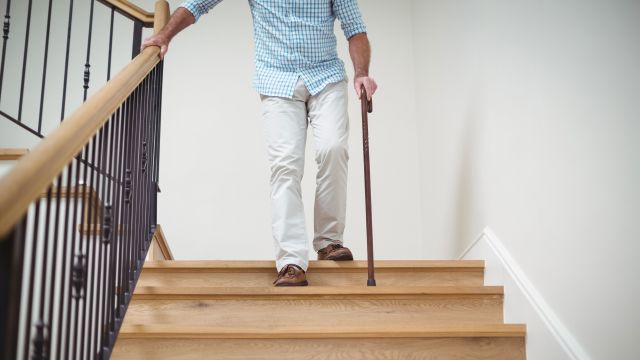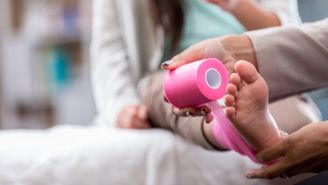Updated on April 19, 2024.
For American adults older than age 65, a fall could be life-threatening—and the rate of deaths from falls in this age group is on the rise, according to the Centers for Disease Control and Prevention (CDC).
Falls are the number one cause of injuries and death from injury among older adults. In fact, about one in four older people in the U.S. have a fall each year. Roughly 36 million falls are reported by older adults annually, according to the CDC. These accidents result in more than 32,000 deaths every year.
Even falls that don’t cause pain can be dangerous for older adults, says Kevin Wang, MD, an orthopedic surgeon with Holy Cross Medical Group in Fort Lauderdale, Florida.
Falls are especially insidious, because even if they aren’t fatal, they can lead to other problems.
"Most patients we see after a fall sustain hip fractures," Dr. Wang says. Falls can also cause head injuries or other bone fractures. And recovery poses its own dangers.
When an older adult has a hip fracture as a result of a fall, they can have problems during their recovery if they’re immobilized and in bed. Being confined to a bed over time can cause heart and lung complications as well as blood clots and pressure ulcers, also known as bedsores, says Wang.
Older adults are at special risk for serious—even deadly—complications following a fall, says Wang. That’s because several healthcare challenges specific to older adults often come into play. These include:
- Older adults often have poor access to health care.
- Older adults are likely to have more than one—and often several—chronic health conditions.
- Health problems, such as heart disease or diabetes, make it easier for an older adult to fall.
- Some older adults have trouble thinking and making decisions, due to dementia or Alzheimer’s disease. These cognitive problems raise the risk for falling.
The CDC notes that although falls are potentially fatal for older adults, these accidents are preventable.
How to fall-proof your home
Did you know that 6 out of 10 falls happen at home? You can improve your safety or that of older loved ones by de-cluttering the home—especially the floor, suggests Wang.
Here are more ways to prevent falls in your home:
- Take throw rugs off the floor. If you have carpets, make sure they are tightly secured to the ground. For tile and wood floors, you can buy no-slip strips to apply to the floor to prevent slips.
- Make sure the house is well-lit. Be especially sure there’s good lighting in potentially dangerous areas like the top of stairs. Use night lights to make sure your loved one can safely walk around the house after hours.
- Install grab bars, railings, and ramps. Consider adding grab bars to the toilet area, as well as the inside and outside the bathtub or shower.
- Apply anti-slip mats to the bathtub. In the bathroom area especially, make sure there are non-skid mats in areas that could get wet and slippery, like in and around the bathtub.
- Be sure they have proper footwear. Pick sturdy, well-fitted shoes that have non-slip soles.
- Keep essentials within reach. Make sure that items your loved one uses regularly are in easy reach.
- Keep track of pets. Always know the location of pets so you don’t accidently slip or fall over them.
It also helps to check in regularly with your older loved one. Ask them if they feel safe at home. If they don't, take steps to make them feel more secure in their space. Make sure they keep a telephone near their bed along with an emergency contact sheet that lists important phone numbers in large, reader-friendly type. In the case of an emergency, they can easily reach for the phone and dial for help.
Check vision and hearing, plus update medications
If you take care of an older adult, have their vision and hearing checked annually. If your loved one wears a hearing aid, make sure it works and fits well. Also, make sure their healthcare provider (HCP) reviews and updates their medications. Some medications or combinations can cause dizziness and falls, notes Wang.
Make sure their primary doctor, pharmacist, or other HCP talks with the patient about how to take their medicines safely.
Maintain a healthy lifestyle
Keeping your body strong is the best possible way to prevent deadly falls, says Wang.
“I can’t say often enough that most falls are preventable. Everyone should start early in their adult life to maintain good health. This includes living a healthy lifestyle, eating a healthy diet, getting regular exercise, maintaining bone health, and having regular medical checkups,” says Wang. “Growing old is not a curse—but not taking care of yourself can be.”
How to get up from a fall
The hard truth is you might not be there when your loved one falls down. But you can teach them to get up properly from a fall. Here's how:
- First, take a few deep breaths to calm down. Then assess if you are hurt and able to properly get up. If you're injured, getting up could make the injuries worse.
- If you feel you can safely get up, roll onto one side, then rest again there to lower blood pressure.
- Slowly move to the hands and knees and crawl to the nearest sturdy chair.
- Place your hands on the seat chair and slide one foot forward so it’s flat on the floor. Make sure the other leg is bent so the knee is touching the floor.
- From this position, slowly rise up and gently turn your body to sit in the chair.
What to do if your loved one experiences a fall
If your loved one hit their head when they fell, lost consciousness even for a few seconds, or shows any sign of confusion, seek immediate medical attention or call 911, even if there’s no sign of obvious injury.
After any fall, even one that seems minor, make an appointment with your HCP. The fall could be related to a health problem, and your HCP will want to evaluate your loved one to find the cause and prevent future falls.
While older adults may fear falling, there are precautionary measures you can take to help them stay safe, like fall-proofing your home and getting them proper footwear.
Perhaps most importantly, make sure they know what to do if they experience a fall: how to get up and who to call for help.







